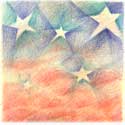|
|
 |
|
|
 |
|
|
This course is designed to afford a deepening of the phenomenological process introduced in the first course. It has as a focus the four elements which served as the basis for the first course. This time the study of the temperamental dispositions which arise as pathologies from the liver, lung, kidney and heart are emphasized. In the elements of art the four elements of earth, water, air and fire are used as a way to look at the organizing principles behind artistic disciplines. The hierarchy of form found in most visual art is an analog of the creative process itself. This idea is central to the task of self transformation which requires discipline and fluidity to exist side by side in the soul.
|
 |
|
|
Lectures will be given on the following topics: The embryological basis for he development of heart, lung, liver and kidneys. The temperamental qualities which arise as part of the biology of the four life organs along with symptoms for recognizing each temperament and temperamental pathology.
|
 |
|
 |
|
 |
The fundamental laws of composition, balance, form and void and the metamorphosis of form will be worked with in this block. The elements of art as seen in the process of composing a simple painting of star shapes will be used to stimulate dialogue about the elemental processes of cognition and sensation which come together in the artistic process. References will be made to the creative processes seen in the embryological analogs in the first period lectures in comparison to the creative analogs underlying artistic activity. The resulting insights will serve as the basis for further exploration of the challenges of inner work. Students will be required to keep journals of their progress.
|
|
 |
|
|
Exercises in the correct rendering of space by recapitulating the historic development of ratio and proportion in drawing is the focus of this block. Simple rendering of ratio by using a measuring stick as a tool for accurate drawing gradually will lead to the use of grids as devices for making accurate transfers of images. From the 14th century orthographic projection as a technique for visualizing the recessionals in a picture will lead to the 15th century discovery of one point perspective and finally multiple point perspective and freehand perspective drawing as a survey of how the depiction of space was analogous to the development of modern scientific consciousness.
|
 |
|
 |



